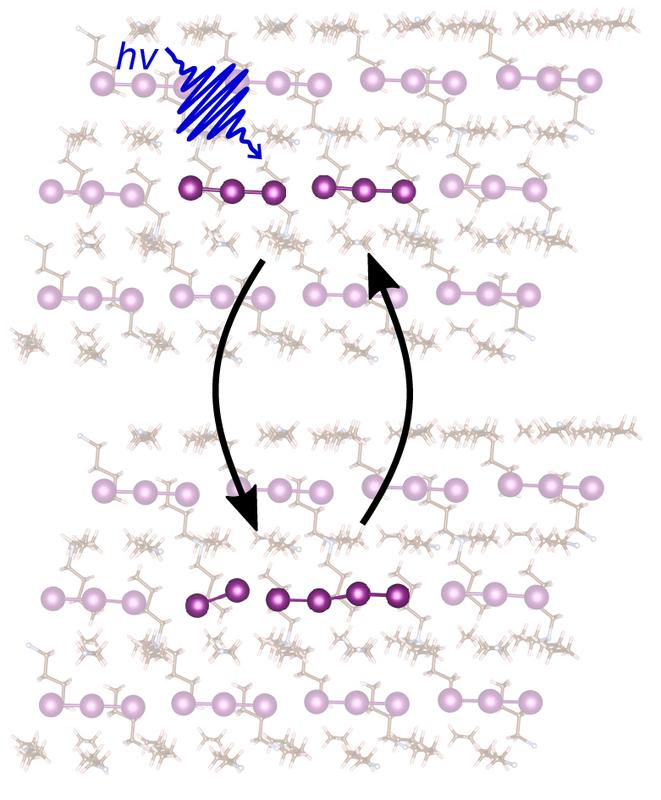Pinball at the atomic level

The picture illustrates the photodissociation of triiodide initiated by a laser pulse and the secondary reaction leading to the novel 4-atom intermediate, followed by the recombination reaction. Image from R. Xian et al. Nat. Chem. (2017), DOI: 10.1038/nchem.2751
The photodissociation of triiodide anion ([I₃]⁻) is a classic textbook reaction that has been extensively studied both in solution and in gas phase. However, probing the ultrafast dynamics of this reaction in the solid state was proven challenging due to partial reversibility of the reaction and its sensitivity to experimental conditions.
Due to an improved sample handling a team of scientists from the MPSD at CFEL and the University of Edinburgh has currently discovered a new reaction intermediate, the tetraiodide radical anion ([I₄]• ⁻), formed as a result of the unique ordering of [I₃]⁻ in the crystal lattice to direct the dissociating I atom – in a process reminiscent of a quantum Newton's cradle. The results have now been published in Nature Chemistry.
In the solution phase, the triiodide anions photodissociates predominantly into iodine radical ([I]•) and diiodide ([I₂]•⁻) radicals. The surrounding solvent plays a passive role in the inertial confinement of the reaction products that ultimately undergo geminate and non-geminate recombination.
In contrast, a dramatically different behavior was found in the ordered ionic lattice of tetra-n-butylammonium triiodide crystals. Here, the local geometry constrains the reaction and, hence, the primary photoproduct, iodine radical ([I]•), is guided by the lattice to form a bond with an adjacent ([I₃]⁻), giving rise to a secondary reaction product, the tetraiodide radical anion ([I₄]• ⁻), not described before for this reaction. As shown in the figure, the reactants are literally aligned in the lattice to form this four-atom intermediate.
“The dissociated iodine atoms collide in a quantum type of a Newton’s cradle with other triiodide molecules to form this novel reaction product” explains Dwayne Miller, and he adds “most importantly, we have demonstrated that lattice can coherently direct the reaction pathway of solid-state photochemistry on femto- to picosecond time scales.”
This phenomenon was only observable thanks to new sample-handling, data collection and analysis techniques developed at the MPSD together with theoretical calculations carried out at the University of Edinburgh to support the electronic and vibrational assignments of the various reaction participants, which enabled the most detailed resolution to date of the reaction intermediates as well as the coherent modes driving the triiodide photodissociation reaction.
“These observations provide a different conceptual framework to think about reaction processes and may point the way in how to couple chemical systems to a bath as a means to increase the length scales under chemical control”, concludes Miller.
http://www.mpsd.mpg.de/en/research/ard/ard – Research website of Prof. Miller
https://dx.doi.org/10.1038/nchem.2751 – Original publication at Nature Chemistry
Media Contact
All latest news from the category: Physics and Astronomy
This area deals with the fundamental laws and building blocks of nature and how they interact, the properties and the behavior of matter, and research into space and time and their structures.
innovations-report provides in-depth reports and articles on subjects such as astrophysics, laser technologies, nuclear, quantum, particle and solid-state physics, nanotechnologies, planetary research and findings (Mars, Venus) and developments related to the Hubble Telescope.
Newest articles

A universal framework for spatial biology
SpatialData is a freely accessible tool to unify and integrate data from different omics technologies accounting for spatial information, which can provide holistic insights into health and disease. Biological processes…

How complex biological processes arise
A $20 million grant from the U.S. National Science Foundation (NSF) will support the establishment and operation of the National Synthesis Center for Emergence in the Molecular and Cellular Sciences (NCEMS) at…

Airborne single-photon lidar system achieves high-resolution 3D imaging
Compact, low-power system opens doors for photon-efficient drone and satellite-based environmental monitoring and mapping. Researchers have developed a compact and lightweight single-photon airborne lidar system that can acquire high-resolution 3D…





















